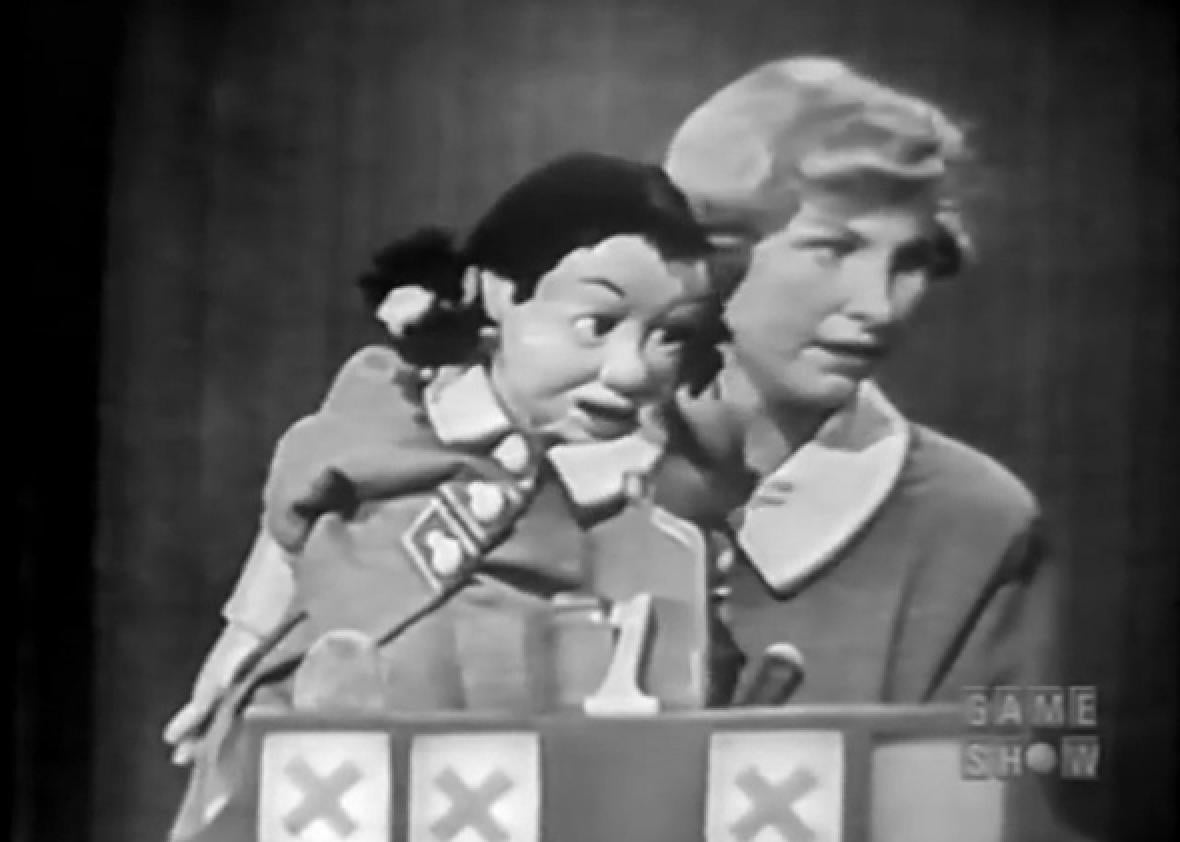Emmy night is here again, and as the nation honors television’s biggest stars, biggest shows, biggest ratings, and biggest paychecks, it’s time to take a look back at the year it all began: 1949, when the First Primetime Emmy Awards were held at the Hollywood Athletic Club. That year—two years before the dawn of transcontinental television broadcasting—only shows produced and airing in Los Angeles were eligible, which perhaps explains why fully one-sixth of the awards that year went to a ventriloquist.
Of course, there were only six awards in total, making it the easiest Emmy field for ventriloquist sweeps in television history. The ventriloquist and dummy who rose to the challenge were Shirley Dinsdale, 22 at the time, and Judy Splinters, whose age could only be determined by cutting her in half and counting the rings. Although clips of Dinsdale’s show, Judy Splinters, are hard to come by, Dinsdale appeared on a 1958 episode of To Tell the Truth, and at 22:27, she brings out her former partner give the audience a taste of the Most Outstanding Television Personality of 1949:
Dinsdale went on to become the Most Retired to Get Married and Raise Children Television Personality of 1953, the Most Went Back to School to Study Respiratory and Cardiopulmonary Therapy Personality of 1970, and the Most Outstanding Head of the Respiratory Therapy Department at John T. Mather Memorial Hospital for an astonishing fourteen years running, from 1973 to 1986. Splinters’ fate remains unknown.
While ventriloquist acts might not command the same respect in the television world today that they did in 1949, prestige television has only become more and more prestigious, sucking up gallon after gallon of prestige from the veins of American culture as the entire medium bloats like the glossiest, highest-production-value tick in the universe. In 1949, the Television Academy plunged its hypostome into America’s jugular for the first time, honoring the first episode of Your Show Time with the Best Film Made for Television Emmy. That episode, an adaptation of Guy de Maupassant’s classic short story “The Necklace,” began TV’s long love affair with literary adaptations. It isn’t online, but the show’s fourth episode, an adaptation of Théophile Gautier’s short story “The Mummy’s Foot,” shows Arthur Shields in the recurring role of a bookstore proprietor who introduced each story:
At the time, advertisers directly produced their shows, and Your Show Time came from American Tobacco. According to producer Stanley Rubin, they refrained from meddling, with one significant exception: killing planned adaptations of works by Tolstoy, Turgenev, and Chekhov as part of a blanket “No Russians” policy. But although modern television is more open to Russians and less open to tobacco companies, the tradition of filtering great works of art through an American lens, then using them to sell products that will someday kill you continues to this day.
Another great American tradition, the celebrity-studded game show that keeps returning with new stars, got its due that year as well, as the Most Popular Television Program award went to Pantomime Quiz. Host Mike Stokey led a celebrity panel in a game of charades on a program that roamed, Ronin-like, from KTLA to CBS to NBC to DuMont to ABC. Here’s an episode from the early 1950s, when it was at CBS, in which Vincent Price plugs Curtain Call at Cactus Creek then tries to pantomime the phrase, “Of all the felt I ever felt, I never felt felt like that felt felt.”
Pantomime Quiz went on to break new ground in the field of reviving the same show every few years: in 1962 it was Stump the Stars, in 1969 it was Mike Stokey’s Stump the Stars, in 1979 it became Celebrity Charades, and then, in 2005, producers Hilary Swank, Chad Lowe, and Bob Balaban revived it one more time at AMC. There was also an Australian version in the 1950s, a chilling prelude to our modern age of the internationally syndicated show formats from Idols to The Office.
Finally, one Emmy tradition that continues to this day is not paying much attention to the technical winners—or really anyone but the stars. KTLA (née W6XYZ) won a station award for Outstanding Overall Performance, which must have been a real kick in the teeth to KTSL, which broadcast the ceremony. Charles Mesak was given a technical award for inventing a device called the phasefader, which could fade a black-on-white title card to white-on-black, but got exactly as much explanation and attention in the contemporary press as the people and companies honored with Technology and Engineering Emmys in 2017 for their work in “Low Latency Remote Controlled Airborne Video Platforms (non-military) For Television.” Last, and, judging from the way he was honored, definitely least, Louis McManus was presented with a special award for designing the Emmy statuette, modeled after his wife. But although McManus’ design went on to become the very symbol of creative achievement in television, that most gracious of media, he didn’t go home with an Emmy statuette that night. They gave him a plaque, instead.
